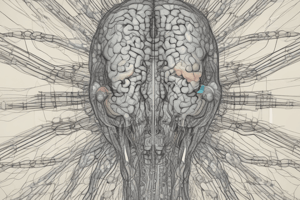Podcast
Questions and Answers
Which motor pathways are responsible for fine motor control?
Which motor pathways are responsible for fine motor control?
- Corticospinal and corticonuclear tracts (correct)
- Corticorubral and corticotectal tracts
- Reticulospinal and rubrospinal tracts
- Lateral vestibulospinal and tectospinal tracts
Which system is responsible for controlling movements of the trunk and lower limbs?
Which system is responsible for controlling movements of the trunk and lower limbs?
- Medial system (correct)
- Pyramidal pathways
- Third system
- Lateral system
What is the primary function of the corticorubral tract?
What is the primary function of the corticorubral tract?
- Fine motor control
- Conscious regulation of extrapyramidal pathways (correct)
- Control of reflex movements
- Involuntary emotional motor skills
Which structure is involved in controlling involuntary emotional motor skills?
Which structure is involved in controlling involuntary emotional motor skills?
What is the primary function of the lateral corticospinal tract?
What is the primary function of the lateral corticospinal tract?
Which motor pathways are corrected by signals from the cortex?
Which motor pathways are corrected by signals from the cortex?
Flashcards are hidden until you start studying
Study Notes
Motor Pathways
- Pyramidal Pathways: Conscious pathways that begin in the cerebral cortex.
- Without Interpolation: For fine motor control, involving the corticospinal and corticonuclear tracts.
- With Interpolation: For conscious regulation of extrapyramidal pathways, involving the corticorubral, corticotectal, corticoreticular, and corticovestibular tracts.
Classification of Motor Pathways
- α: Anatomical Point of View: Classified based on where they begin and end.
- β: Functional Point of View: Classified based on their function.
Functional Classification of Motor Pathways
- Medial System: Majority of extrapyramidal pathways, controlling movements of the trunk and lower limbs, mainly involving muscles of the back.
- Involved tracts: Anterior corticospinal, tectospinal, lateral vestibulospinal tracts.
- Lateral System: Controls fine motor skills, predominantly in the upper limbs.
- Involved tracts: Lateral corticospinal and rubrospinal tracts.
- Third System: Involuntary emotional motor skills, including body language, under the impact of the hypothalamus and limbic system (amygdala).
- Involved tracts: Reticulospinal tract.
- Functions: Protective or aggressive movements, muscle tremor.
Studying That Suits You
Use AI to generate personalized quizzes and flashcards to suit your learning preferences.




